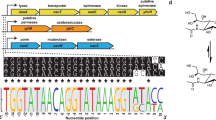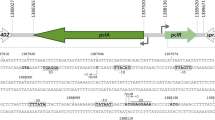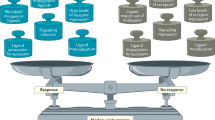Abstract
LACTOFERRIN, an iron-binding glycoprotein found in high concentrations in human milk and other epithelial secretions1 and in the secondary (specific) granules of neutrophils2, is thought to be responsible for primary defence against microbial infection, mainly as a result of lactoferrin sequestration of iron required for microbial growth3. Many other functions have been attributed to lactoferrin, including immunomodulation and cell growth regulation (reviewed in ref. 4). Some of these functions appear to be at least in part independent of the iron-binding activity of lactoferrin. It also has been consistently observed that lactoferrin interacts avidly with nucleic acids5–7. Lactoferrin enhancement of the activity of natural killer and lymphokine-activated killer cells in vitro is inhibited by RNA and DNA8. Lactoferrin taken up by K562 human myelogenous leukaemia cells appears in the nucleus where it is bound to DNA9. We report here that binding of lactoferrin to DNA occurs under stringent conditions with distinct sequence specificity, and that interaction between lactoferrin and these sequences intracellularly leads to transcriptional activation.
This is a preview of subscription content, access via your institution
Access options
Subscribe to this journal
Receive 51 print issues and online access
$199.00 per year
only $3.90 per issue
Buy this article
- Purchase on Springer Link
- Instant access to full article PDF
Prices may be subject to local taxes which are calculated during checkout
Similar content being viewed by others
References
Lonnerdal, B. & Woodhouse, L. Nutr. Res. 8, 853–858 (1988).
Spik, G. et al. Br. Med. J. 5, 69–74 (1978).
Weinberg, E. D. Microbiol. Rev. 42, 45–66 (1978).
Lyer, S. & Lonnerdal, B. Eur. J. clin. Nutr. 47, 232–241 (1993).
Bennett, R. M. et al. J. clin. Invest. 71, 611–618 (1983).
Hutchens, T. W. et al. Pediat. Res. 29, 243–250 (1991).
Bennett, R. M. & Davis, J. J. Immun. 127, 1211–1216 (1981).
Shau, H. et al. J. Leuk. Biol. 51, 343–349 (1992).
Garre, C. et al. J. Cell Physiol. 153, 477–482 (1992).
Siebenlist, U. et al. Cell 37, 381–388 (1984).
Zhang, X. Y. et al. Analyt. Biochem. 201, 366–370 (1992).
Walmer, D. K. et al. Endocrinology 131, 1458–1466 (1992).
Meier, U. T. & Blobel, G. J. Cell Biol. 111, 2235–2245 (1990).
Ziere, G. J. et al. J. biol. Chem. 268, 27069–27075 (1993).
Bezault, J. et al. Cancer Res. 54, 2310–2312 (1994).
Broxmeyer, H. E. et al. Blood Cells 13, 31–48 (1987).
Zucali, J. R. et al. Blood 69, 33–37 (1987).
Zucali, J. R. et al. Blood 70, 191a (1987).
Hashizume, S. et al. Biochim. biophys. Acta 763, 377–382 (1983).
Green, C. et al. Proc. Soc. exp. Biol. Med. 137, 1311–1317 (1971).
Miyauchi, J. & Watanabe, Y. Cell Tissue Res. 247, 249–258 (1987).
Weinberg, E. D. Life Sci. 50, 1289–1297 (1992).
Funk, W. D. et al. Molec. cell. Biol. 12, 2866–2871 (1992).
Rikitake, Y. & Moran, E. Molec. cell. Biol. 12, 2826–2836 (1992).
Higuchi, R. et al. Nucleic Acids Res. 16, 7351–7369 (1988).
Seed, B. & Sheen, J. Y. Gene 67, 271–278 (1988).
An, G. et al. Molec. cell. Biol. 2, 1628–1633 (1982).
Author information
Authors and Affiliations
Rights and permissions
About this article
Cite this article
He, J., Furmanski, P. Sequence specificity and transcriptional activation in the binding of lactoferrin to DNA. Nature 373, 721–724 (1995). https://doi.org/10.1038/373721a0
Received:
Accepted:
Issue Date:
DOI: https://doi.org/10.1038/373721a0
This article is cited by
-
Gene expression of renal lactoferrin and glycemic homeostasis in diabetic rats with reference to the protective role of exogenous bovine lactoferrin
The Journal of Basic and Applied Zoology (2020)
-
Two novel synthetic peptides inhibit quorum sensing-dependent biofilm formation and some virulence factors in Pseudomonas aeruginosa PAO1
Journal of Microbiology (2019)
-
Exercise increases lactoferrin, but decreases lysozyme in salivary granulocytes
European Journal of Applied Physiology (2017)
-
Archetypal tryptophan-rich antimicrobial peptides: properties and applications
World Journal of Microbiology and Biotechnology (2016)
-
Tip110 binding to U6 small nuclear RNA and its participation in pre-mRNA splicing
Cell & Bioscience (2015)
Comments
By submitting a comment you agree to abide by our Terms and Community Guidelines. If you find something abusive or that does not comply with our terms or guidelines please flag it as inappropriate.



